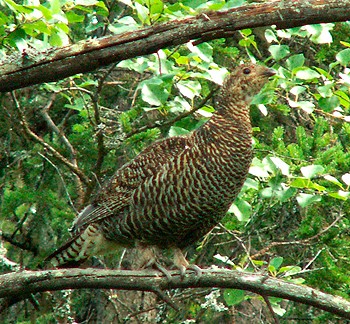News
Moorland for your money
<strong>Modern ways to restore grouse moors</strong>
Would you like to speak to our readers? We offer sponsored articles and advertising to put you in front of our audience. Find out more.
There can be few sports more synonymous with wealth and opulence than grouse shooting. The very mention of the subject conjures up images of palatial Highland lodges, vast expanses of rolling heather and teams of hard-working, tweed-clad keepers.
To an extent, all this is true, but one Moray-based moorland manager has demonstrated that, with the use of modern technical innovation, grouse shooting need not exceed the reach of the average sportsman or woman.
Dick Bartlett is a man with a passion for grouse. He is the managing director of British Moorlands, which promotes modern, innovative techniques to support sound gamekeeping practices on grouse moors, thus improving their financial performance, to reverse the decline in sub-prime moorland across the UK.
During the late 1970s, grouse shooting on many of these neglected moors was deemed to be no longer economically viable, but Dick believes that that situation can now be reversed.
Decline and dereliction
Speaking at his home on Speyside, Dick explained that many of the smaller sub-prime British grouse moors fell into decline and dereliction because of a failure to address effectively problems with changing weather patterns, large-scale conifer afforestation and the rapid increase in predator populations.
On such moorlands, the expensive management methods ? employing a large labour force ? that prove successful on larger, more productive prime moors, are usually ineffective.
Approximately 50 per cent of Scotland?s heather moorland is classed as sub-prime, as is a staggering 100 per cent of the moorland in both Wales and Ireland.
Dick believes that the way to bring sub-prime moors back into production is by using mechanisation, automation and innovation. After all, as he points out, workers in agriculture and forestry do not depend on outdated techniques, so why should grouse keepers?
On a large, well-staffed, economically self-sustaining moor, the control of old rank heather by burning is an effective and logical approach. On a lesser moor, where costs must be kept down and manpower is scarce, controlled strip burning is often impractical. As a result, large swathes of heather are often burned off, in the belief that this will benefit the grouse population.
Sadly, this is not true. As Dick highlighted, these large areas of open burn provide little shelter for feeding grouse chicks but perfect conditions for predatory raptors. In addition, the long, straight edges of burned moorland are easily patrolled by four-footed predators such as the hunting fox, as well as birds of prey.
Matrix revolution
Dick has proved that a much more grousefriendly approach is the ?narrow strip matrix? technique, whereby a dual-wheeled moorland tractor with a heather flail (used by many estates to control gorse and scrub) is used to cut hundreds of metres of narrow, intersecting, irregular (roughly S-shaped) swathes through old rank heather. This all-weather technique may also be employed when conditions do not allow for heather burning.
By using this method, up to 10 acres of swipes may be cut in a day ? equating to 30 miles of serpentine, sheltering edge. Thus, young grouse feeding on fresh green heather shoots are seldom more than a few metres from life-saving cover ? essential should the silhouette of a hen harrier appear on the horizon.
Furthermore, the curved configuration of these cut swathes makes the approach for an aerial attack diffi cult ? a quite ingenious way of controlling the predatory effects of protected raptor species. This labyrinthine pattern also makes hunting difficult for four-legged predators, and creates something of an improved microclimate that reduces the detrimental effect of wind chill on broods, thus tipping the odds for survival in favour of the young grouse.
Automatic trap-checking
A further example of how Dick has incorporated existing technology into moorland management is the use of his own electronic automatic trap-checking (ATC) system. Used extensively over the past decade, this system allows for an efficient degree of legal vermin control over moorland where manpower might be limited by financial constraints.
This fail-safe electronic system works by the use of ?positive feedback?, with a transmitter fitted to the trap sending a signal to a receiver (over a distance of three to five miles in a clear line of sight) every hour to indicate that nothing has been caught. When the transmitter fails to send a signal, it means that something has been caught and that the trap should be checked. A receiver station can handle the data from up to 100 transmitters and can be linked to a mobile phone.
When one considers that up to 80 per cent of a grouse keeper?s work is related to vermin control, and 80 per cent of that daily routine is taken up with the checking of traps and snares, it quickly becomes apparent just what a laboursaving device the ATC is.
Another innovation that Dick has found beneficial is the use of a divot plough to improve grouse habitat on moorland blanket bog. By using this device in partnership with the dual-wheeled moorland tractor, short strips can be ploughed, providing water and shelter where little existed before. The divots produced are also a good place to position grit, and can provide an ideal lookout post from which adult grouse can spot any approaching predators.
The sink effect
Dick was also keen to stress just how vital vermin control is on neighbouring estates if sub-prime moorland is to achieve its full potential in grouse production. Should surrounding estates not execute a rigorous policy of vermin control, a ?sink effect? will be experienced and the managed sub-prime moor will become a game-rich oasis in a vermin-filled desert. Predatory species will be drawn in by the presence of grouse, and the already hard-pressed moorland managers will find themselves struggling to cope with a rocketing vermin population.
There are those who might question Dick?s high-tech approach, but with his proven record for resurrecting declining moorland ? his success winning him a place in the finals of the Purdey Awards in 2010 ? his groundbreaking management techniques are hard to argue against.
If further validation of his ideas were required, one need only study the impressive results: derelict subprime moorland at Shenwell, Achmore Hill and Carronbridge have all been subject to Dick?s innovative management techniques, and are now each producing more than 40 brace of grouse per 1,000 acres, which constitutes a moor of driven standard. All of this has been achieved within four years of Dick?s management commencing, and at only a third of the cost of more traditional grouse management methods.
These statistics are impressive ? even more so when one realises that the results better the 35.6 brace per 1,000 acres that was stated by the Game & Wildlife Conservation Trust as being the maximum achievable on a selection of 23 moors in the same region.
To learn more about Dick?s approach to grouse moor management, visit the British Moorlands website, www.britishmoorlands.com, or email Dick at dick@britishmoorlands.com.
Related articles
News
PETA attacks royal couple for breeding cocker pups
The Prince and Princess of Wales have faced criticism from animal rights group PETA after they had a litter of puppies
By Time Well Spent
News
Farmers launch legal review against Reeves’s farm tax
Chancellor Rachel Reeves faces a judicial review over inheritance tax reforms that could force family farms out of business
By Time Well Spent
Manage Consent
To provide the best experiences, we use technologies like cookies to store and/or access device information. Consenting to these technologies will allow us to process data such as browsing behavior or unique IDs on this site. Not consenting or withdrawing consent, may adversely affect certain features and functions.
Functional Always active
The technical storage or access is strictly necessary for the legitimate purpose of enabling the use of a specific service explicitly requested by the subscriber or user, or for the sole purpose of carrying out the transmission of a communication over an electronic communications network.
Preferences
The technical storage or access is necessary for the legitimate purpose of storing preferences that are not requested by the subscriber or user.
Statistics
The technical storage or access that is used exclusively for statistical purposes.
The technical storage or access that is used exclusively for anonymous statistical purposes. Without a subpoena, voluntary compliance on the part of your Internet Service Provider, or additional records from a third party, information stored or retrieved for this purpose alone cannot usually be used to identify you.
Marketing
The technical storage or access is required to create user profiles to send advertising, or to track the user on a website or across several websites for similar marketing purposes.





